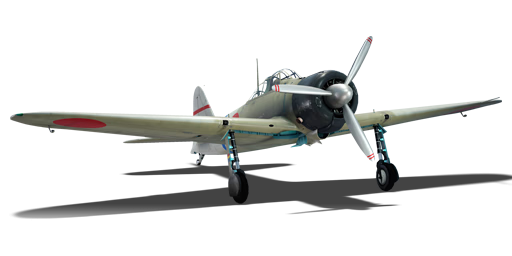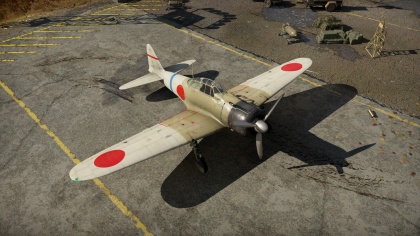A6M2 mod. 11
Contents
| This page is about the Japanese fighter A6M2 mod. 11. For other uses, see A6M (Family). |
Description
The A6M2 mod. 11 is a rank II Japanese fighter
with a battle rating of 3.3 (AB/SB) and 3.7 (RB). This aircraft was introduced in Update 1.39.
The "Zero" is almost the ideal dog-fighter. Very good turn times and 2 x 20 mm cannons make this aircraft a frightening foe. Use your superior turn time and better overall manoeuvrability to get on the tail of the enemy. Be mindful of the low ammo count. Historically, as well as in the game, the A6M series was stripped of all armour to lighten the aircraft (achieving its amazing manoeuvrability). This means that your pilot is easily sniped and your fuel tanks, which are not protected, catch on fire very easily.
Although this aircraft can carry bombs, it makes you an easy target and is really not worth the added weight in realistic or simulator battles. It is slower compared to most of the opposition, thus be mindful of what is around you.
Landing and runway manoeuvrability is good, but with no tail hook, you can find your self careening off the end of carriers. Landing on a carrier with this land-based version requires a careful hand. With an approach speed of 120 km/h (90 mph), landing flaps and gear down approach a moving carrier from behind. When setting down on the flight deck immediately pull up the flaps, push the brake and pull up with the elevator (past the stall speed of 90 km/h (60 mph)).
General info
Flight Performance
Describe how the aircraft behaves in the air. Speed, manoeuvrability, acceleration and allowable loads - these are the most important characteristics of the vehicle.
| Characteristics | |||||||
|---|---|---|---|---|---|---|---|
| Stock | |||||||
| Max Speed (km/h at 4,400 m) |
Max altitude (meters) |
Turn time (seconds) |
Rate of climb (meters/second) |
Take-off run (meters) | |||
| AB | RB | AB | RB | AB | RB | ||
| 491 | 476 | 10300 | 17.7 | 18.2 | 10.1 | 10.1 | 175 |
| Upgraded | |||||||
| Max Speed (km/h at 4,400 m) |
Max altitude (meters) |
Turn time (seconds) |
Rate of climb (meters/second) |
Take-off run (meters) | |||
| AB | RB | AB | RB | AB | RB | ||
| 531 | 510 | 10300 | 16.7 | 17.0 | 17.5 | 13.3 | 175 |
Details
| Features | ||||
|---|---|---|---|---|
| Combat flaps | Take-off flaps | Landing flaps | Air brakes | Arrestor gear |
| ✓ | ✓ | ✓ | X | X |
| Limits | ||||
|---|---|---|---|---|
| Wing-break speed (km/h) |
Gear limit (km/h) |
Combat flaps (km/h) |
Max Static G | |
| + | - | |||
| 510 | ~14 | ~7 | ||
| Optimal velocities | |||
|---|---|---|---|
| Ailerons (km/h) |
Rudder (km/h) |
Elevators (km/h) |
Radiator (km/h) |
| < 270 | < 420 | < 410 | > 324 |
| Compressor (RB/SB) | ||
|---|---|---|
| Setting 1 | ||
| Optimal altitude | 100% Engine power | WEP Engine power |
| 3,400 m | 950 hp | 1,075 hp |
Survivability and armour
Examine the survivability of the aircraft. Note how vulnerable the structure is and how secure the pilot is, whether the fuel tanks are armoured, etc. Describe the armour, if there is any, and also mention the vulnerability of other critical aircraft systems.
Armaments
Offensive armament
The A6M2 mod. 11 is armed with:
- 2 x 20 mm Type 99 Model 1 navy cannons, wing-mounted (60 rpg = 120 total)
- 2 x 7.7 mm Type 97 navy machine guns, nose-mounted (680 rpg = 1,360 total)
Suspended armament
The A6M2 mod. 11 can be outfitted with the following ordnance:
- Without load
- 2 x 60 kg Navy Type 97 Number 6 bombs (120 kg total)
Usage in battles
Describe the tactics of playing in an aircraft, the features of using vehicles in a team and advice on tactics. Refrain from creating a "guide" - do not impose a single point of view, but instead, give the reader food for thought. Examine the most dangerous enemies and give recommendations on fighting them. If necessary, note the specifics of the game in different modes (AB, RB, SB).
Manual Engine Control
| MEC elements | ||||||
|---|---|---|---|---|---|---|
| Mixer | Pitch | Radiator | Supercharger | Turbocharger | ||
| Oil | Water | Type | ||||
| Controllable | Controllable Not auto controlled |
Controllable Not auto controlled |
Controllable Not auto controlled |
Separate | Not controllable 1 gear |
Not controllable |
Modules
| Tier | Flight performance | Survivability | Weaponry | ||
|---|---|---|---|---|---|
| I | Fuselage repair | Radiator | Offensive 7 mm | ||
| II | Compressor | Airframe | New 7 mm MGs | 9 in (mod30) | |
| III | Wings repair | Engine | Offensive 20 mm | ||
| IV | Engine injection | Cover | New 20 mm cannons | ||
Pros and cons
Pros:
- Aside from Biplanes (and the Ki-27), has the best turn time and manoeuvrability
- Low stall speed
- Powerful cannons
- Small target
- Air spawn on sea maps
Cons:
- Moderately slow
- No armour or pilot protection (just the metal shell)
- A lot of bars in the cockpit
- No tail hook. Later A6Ms fix this
- Not very good in dives
- Guns easily overheat
- Fires extremely likely. Most common vehicle destruction is from being set alight and burning down
- Low cannon ammunition count
History
The A6M2 mod. 11 was the third prototype to be built. It was powered by a 950 hp Nakajima Sakae engine. Production started in 1939 and a total of 64 were built. These aircraft did see combat in China.
Encyclopedia info
At its launch, the A6M2 model 11 knew no equal.
This single-seater carrier-based fighter was designed to replace the ageing A5M. To reduce its weight, duralumin was widely used, and its propeller was made of a lightweight aluminium alloy. The A6M2 did not have high survivability due to its lack of armour and self-sealing fuel tanks, but in the first half of World War II, it had a considerable advantage in manoeuvrability and speed when compared to the Allies (which had nothing to oppose the Zero until the arrival of aircraft such as the F4U and F6F).
The first prototype of this series, the A6M1, first flew on April 1, 1939. During the test, a more powerful engine was proposed, and the Mitsubishi Zuisei 13 (780 hp) was replaced with the Nakajima Sakae 12 (940 hp). After a successful test flight, the new engine was adopted for serial production and the plane was designated the A6M2 Model 11. Its main drawback was that it could not be used on aircraft carriers due to its large wingspan, which was not designed for carrier-based operations. To circumvent this limitation, the A6M2 model 21 was designed with folding 500 mm wing panels.
The Zero had no equal in the sky until the end of 1942, and even when it was finally made obsolete, its production continued until the end of the war, making it the most popular fighter in Japan. Like many other Japanese aircraft, the Zero was used in the last months of the war to attack bombers.
A total of 740 A6M2 model 21s were built in Mitsubishi plants; 326 were built in Nakajima plants.
Media
Skin and Camouflages for the A6M2 mod. 11 in Warthunder Live.
See also
- Related development
- Aircraft of comparable role, configuration and era
- Brewster F2A Buffalo
- Curtiss-Wright CW-21
- Fiat G.50
- Grumman F4F Wildcat
- Grumman F6F Hellcat
- IAR-81
- Macchi C.200
- Nakajima Ki-43 Oscar
- Supermarine Seafire
- Hawker Sea Hurricane
External links
| Mitsubishi Company (三菱商会) | |
|---|---|
| Fighters | A5M4 · Hagiri's A5M4 |
| A6M2 mod. 11 · A6M2 · A6M3 · A6M3 mod. 22 · A6M3 mod. 22Ko · A6M5 · A6M5 Ko · A6M5 otsu · A6M5 Hei · A6M6c | |
| A7M1 (NK9H) · A7M2 | |
| J2M2 · J2M3 · J2M4 Kai · J2M5 · J2M5 (30 mm) | |
| Hydroplanes | F1M2 |
| Interceptors | Ki-83 · Ki-109 |
| Bombers | G4M1 |
| Ki-21-Ia · Ki-21-I hei · Ki-67-I Ko · Ki-67-I otsu | |
| Jet Fighters | Ki-200 |
| Captured | ▃A6M2 · ␗A6M2 |
| See also | Mitsubishi Heavy Industries, Ltd. (Post-War) |
| Japan fighters | |
|---|---|
| Navy | |
| Carrier-based fighter | |
| A5M | A5M4 · Hagiri's A5M4 |
| A6M | A6M2 mod. 11 · A6M2 · A6M3 · A6M3 mod. 22 · A6M3 mod. 22Ko · A6M5 · A6M5 Ko · A6M5 otsu · A6M5 Hei · A6M6c |
| A7He | A7He1* |
| A7M | A7M1 (NK9H) · A7M2 |
| Land-based Fighter | |
| J2M | J2M2 · J2M3 · J2M4 Kai · J2M5 · J2M5 (30 mm) |
| J6K | J6K1 |
| J7W | J7W1 |
| N1K-J | N1K1-Ja · N1K2-J · N1K2-Ja |
| Fighter seaplane | |
| N1K | N1K1 |
| A6M-N | A6M2-N |
| Army | |
| Ki-10 | Ki-10-I · Ki-10-I C · Ki-10-II · Ki-10-II C |
| Ki-27 | Ki-27 otsu · Ki-27 otsu Tachiarai |
| Ki-43 | Ki-43-I · Ki-43-II · Ki-43-III otsu |
| Ki-44 | Ki-44-I · Ki-44-I 34 · Ki-44-II otsu · Ki-44-II hei |
| Ki-61 | Ki-61-I ko · Ki-61-I otsu · Ki-61-I hei · Tada's Ki-61-I hei · Ki-61-I tei · Ki-61-II Otsu Kai |
| Ki-84 | Ki-84 ko · Ki-84 otsu · Ki-84 hei |
| Ki-87 | Ki-87 |
| Ki-94 | Ki-94-II |
| Ki-100 | Ki-100 · Ki-100-II |
| Other countries | ▅F4U-1A · ▅P-51C-11-NT · ▅Bf 109 E-7 · ▅Fw 190 A-5 |
| *Imported designation of the He 112 (A6M was in development - A7M would take A7 designation after the cancelation of the A7He) | |





